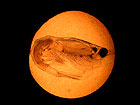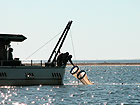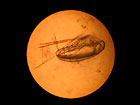

 | |||||||||||||||||||||
|
|
Journals 2006/2007Kirk Beckendorf
September 3, 2006 Bob is one of the marine biologists who specialize in zooplankton. He calls them "bugs" but they aren't insects at all. The bowhead whales' main food source is zooplankton, particularly copepods and euphausiids (krill). Copepods are smaller than a flea, the krill we have been finding are an inch or less long and look like little shrimp.
We tow special plankton nets behind the boat to catch them. Everything collected is stored and preserved in plastic bottles. One of the many things Bob does when we get back to BASC is to pull sub samples from each bottle. He takes out individual copepods and examines them under the microscope to determine their species and gender. Then each is numbered and photographed with a digital camera attached to the microscope. He showed me how to looking under the microscope and use tweezers to grab each copepod and then place it in its on individual compartment in a number tray, for later analysis.
The copepod's long oval "fat" sack, darkly outlined, is easily seen because it fills up the majority of the body cavity. Because the copepods are made up of so much fat they are a very nutritious food source for the whales.
Later back at the University of Rhode Island where Bob works, he will analyze each individual copepod. Among other things he will measure the amount of nitrogen and carbon, which they contain. This can tell him the weight of each copepod and the amount of fat each contains. He will also measure the size of the copepod and make a comparison to the amount of carbon and nitrogen. With humans there is considered a best weight for a given height. For instance if a person is 5' 8" tall they should weigh a certain amount. Bob will make a similar comparison for EACH copepod comparing their C/N and their length. Unlike humans, it seems that being fat is a good thing if you are a copepod. Fat has a lot of energy, so the more fat they have, the more energy for over wintering and surviving in the cold arctic waters. In the frigid arctic many living things rely on storing fat. To generalize the more fat the better. On a larger scale than copepods, polar bears also store and have layers of fat. Some recent research indicates that the amount of fat the bears have has decreased as the amount of sea ice has also declined because of climate change (global warming). Not a good thing if you are a polar bear. Bowhead whales have a very thick layer of fat/blubber just under their skin. It can be up to 20 inches thick. Imagine how many copepods and krill it would take to make you fat. We heard today that one of the villages east of here killed a whale this week. Biologists found that it was full of copepods. Question of the day: How can a whale 60 feet long catch and eat something the size of a flea? |
||||||||||||||||||||




